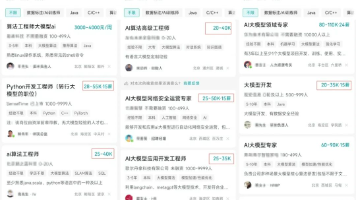《AI 模型训练平台选型指南:中小团队的低成本落地路径》
AI模型训练平台选型指南:中小团队的低成本落地路径 本文针对中小团队在AI落地过程中面临的技术门槛高、成本控制难等挑战,提出了一套实用的AI模型训练平台选型方法论。文章首先分析了传统开发模式的瓶颈,如实验追踪困难、资源管理低效等问题,对比了平台化训练在自动化、标准化方面的优势。通过代码示例展示了专业平台如何实现资源分配、实验追踪、模型注册等核心功能。重点介绍了成本效益分析模型,从直接成本(订阅费、

在 AI 技术飞速渗透各行各业的当下,我们早已告别 “谈 AI 色变” 的观望阶段,迈入 “用 AI 提效” 的实战时代 💡。无论是代码编写时的智能辅助 💻、数据处理中的自动化流程 📊,还是行业场景里的精准解决方案 ,AI 正以润物细无声的方式,重构着我们的工作逻辑与行业生态 🌱。曾几何时,我们需要花费数小时查阅文档 📚、反复调试代码 ⚙️,或是在海量数据中手动筛选关键信息 ,而如今,一个智能工具 🧰、一次模型调用 ⚡,就能将这些繁琐工作的效率提升数倍 📈。正是在这样的变革中,AI 相关技术与工具逐渐走进我们的工作场景,成为破解效率瓶颈、推动创新的关键力量 。今天,我想结合自身实战经验,带你深入探索 AI 技术如何打破传统工作壁垒 🧱,让 AI 真正从 “概念” 变为 “实用工具” ,为你的工作与行业发展注入新动能 ✨。
文章目录
AI 模型训练平台选型指南:中小团队的低成本落地路径 🚀
在人工智能浪潮席卷各行各业的今天,中小团队面临着巨大的机遇与挑战。据最新统计,超过70%的中小企业在AI落地过程中遇到技术门槛高、成本控制难、人才短缺等困境。然而,选择合适的AI模型训练平台,能够帮助团队将模型开发成本降低60%,部署时间缩短50%以上!
作为经历过从零开始搭建AI平台的技术负责人,我深刻理解中小团队的痛点:有限的预算、紧凑的时间表、多样化的需求。本文将分享一套经过实践验证的选型方法论,帮助你在众多平台中找到最适合的解决方案。
为什么中小团队需要专业的AI训练平台?💡
传统开发模式的瓶颈
许多团队最初尝试使用简单的脚本和开源库进行模型训练,但很快会遇到 scalability 问题:
# 典型的初级团队训练代码 - 面临诸多挑战
import tensorflow as tf
from sklearn.model_selection import train_test_split
import pandas as pd
# 数据加载和预处理
def load_data():
data = pd.read_csv('data.csv')
X = data.drop('target', axis=1)
y = data['target']
return train_test_split(X, y, test_size=0.2)
X_train, X_test, y_train, y_test = load_data()
# 简单模型训练
model = tf.keras.Sequential([
tf.keras.layers.Dense(128, activation='relu'),
tf.keras.layers.Dense(64, activation='relu'),
tf.keras.layers.Dense(1, activation='sigmoid')
])
model.compile(optimizer='adam', loss='binary_crossentropy', metrics=['accuracy'])
# 开始训练 - 但缺乏监控、版本控制、自动化等能力
history = model.fit(X_train, y_train, epochs=10, validation_data=(X_test, y_test))
这种模式在项目初期可能有效,但随着项目复杂度的增加,会面临以下问题:
- 实验追踪困难:无法系统记录超参数、数据版本和结果
- 资源管理低效:GPU资源分配不合理,存在闲置或争抢
- 协作流程混乱:团队成员间代码、模型、数据版本不一致
- 部署复杂度高:从训练到上线的过渡充满技术债务
平台化带来的价值提升
专业的AI平台通过标准化流程和自动化工具,为团队带来多重价值:
# 平台化训练的优势示例
class PlatformTrainingPipeline:
def __init__(self, platform_client):
self.client = platform_client
self.experiment_tracker = platform_client.get_experiment_tracker()
self.model_registry = platform_client.get_model_registry()
def run_training(self, config):
"""平台化训练流程"""
# 1. 自动资源分配
resources = self.client.allocate_gpu(config.gpu_requirements)
# 2. 数据版本管理
dataset = self.client.get_dataset_version(config.dataset_version)
# 3. 实验追踪
with self.experiment_tracker.start_run(config.experiment_name) as run:
run.log_parameters(config.hyperparameters)
# 4. 自动化训练
model = self.train_model(dataset, config)
# 5. 性能评估和记录
metrics = self.evaluate_model(model, dataset.test_set)
run.log_metrics(metrics)
# 6. 模型注册
if metrics.accuracy > config.threshold:
self.model_registry.register_model(model, config.version_policy)
# 7. 自动资源释放
self.client.release_resources(resources)
AI训练平台核心能力评估框架 🔍
成本效益分析模型
中小团队选型的首要考量是成本。我们建立了多维度的成本评估模型:
class CostBenefitAnalyzer:
def __init__(self, team_size, expected_projects, budget_constraints):
self.team_size = team_size
self.expected_projects = expected_projects
self.budget = budget_constraints
def calculate_total_cost(self, platform_pricing):
"""计算平台总拥有成本"""
# 直接成本
subscription_cost = platform_pricing.monthly_fee * 12
compute_cost = self.estimate_compute_usage(platform_pricing.compute_rates)
storage_cost = self.estimate_storage_needs(platform_pricing.storage_rates)
# 间接成本(时间节省带来的价值)
time_savings = self.calculate_time_savings(platform_pricing.efficiency_gains)
training_cost_reduction = self.estimate_training_efficiency(platform_pricing)
total_direct_cost = subscription_cost + compute_cost + storage_cost
total_indirect_benefit = time_savings + training_cost_reduction
return {
'direct_costs': total_direct_cost,
'indirect_benefits': total_indirect_benefit,
'net_cost': total_direct_cost - total_indirect_benefit,
'roi': total_indirect_benefit / total_direct_cost
}
def estimate_compute_usage(self, compute_rates):
"""估算计算资源使用量"""
# 基于项目类型和数量的经验公式
base_hours = 100 # 每个项目基础训练时数
gpu_hours = base_hours * self.expected_projects * 1.5 # 考虑调参开销
return gpu_hours * compute_rates.gpu_hourly_rate
def calculate_time_savings(self, efficiency_gains):
"""计算效率提升带来的时间节省价值"""
# 工程师时间成本(按市场价估算)
engineer_hourly_rate = 5000 / 22 / 8 # 月薪5000,22工作日,8小时
# 平台带来的效率提升
time_reduction = efficiency_gains.estimated_time_savings # 百分比
estimated_training_time = 200 # 小时/项目
total_time_savings = (estimated_training_time * time_reduction *
self.expected_projects * self.team_size)
return total_time_savings * engineer_hourly_rate
技术能力评估指标体系
从技术角度,我们关注以下核心能力:
class PlatformCapabilityAssessment:
def __init__(self, platform_name, technical_requirements):
self.platform = platform_name
self.requirements = technical_requirements
self.scores = {}
def evaluate_ml_frameworks(self):
"""评估框架支持能力"""
supported_frameworks = self.platform.get_supported_frameworks()
required_frameworks = self.requirements.ml_frameworks
support_score = len(set(supported_frameworks) & set(required_frameworks)) / len(required_frameworks)
# 考虑版本支持和定制能力
version_support = self.assess_version_support()
customization_capability = self.assess_customization()
return {
'support_score': support_score,
'version_support': version_support,
'customization': customization_capability,
'overall': support_score * 0.5 + version_support * 0.3 + customization * 0.2
}
def evaluate_automl_capabilities(self):
"""评估AutoML能力"""
automl_features = self.platform.automl_features
evaluation_criteria = {
'feature_engineering': 0.2,
'hyperparameter_optimization': 0.3,
'model_selection': 0.2,
'pipeline_automation': 0.3
}
total_score = 0
for feature, weight in evaluation_criteria.items():
feature_score = self.rate_feature(automl_features.get(feature, {}))
total_score += feature_score * weight
return total_score
def assess_scalability(self):
"""评估扩展性"""
scaling_limits = self.platform.scaling_limits
our_requirements = self.requirements.scaling_needs
# 计算扩展性匹配度
compute_scaling = min(scaling_limits.max_gpus / our_requirements.max_gpus, 1)
data_scaling = min(scaling_limits.max_data_size / our_requirements.max_data_size, 1)
user_scaling = min(scaling_limits.max_users / our_requirements.team_size, 1)
return (compute_scaling + data_scaling + user_scaling) / 3
主流平台深度对比分析 🏆
云服务商平台评估
AWS SageMaker:企业级全功能解决方案
# AWS SageMaker 使用示例
import sagemaker
from sagemaker import Session
from sagemaker.sklearn import SKLearn
class SageMakerIntegration:
def __init__(self, role_arn, bucket_name):
self.session = sagemaker.Session()
self.role = role_arn
self.bucket = bucket_name
def run_training_job(self, training_script, instance_type='ml.m5.large'):
"""运行训练任务"""
sklearn_estimator = SKLearn(
entry_point=training_script,
role=self.role,
instance_type=instance_type,
framework_version='0.23-1',
py_version='py3',
instance_count=1,
hyperparameters={'epochs': 10, 'batch-size': 32}
)
# 启动训练任务
sklearn_estimator.fit({'training': f's3://{self.bucket}/data/train'})
return sklearn_estimator
def deploy_model(self, estimator, endpoint_name):
"""部署模型到端点"""
predictor = estimator.deploy(
initial_instance_count=1,
instance_type='ml.t2.medium',
endpoint_name=endpoint_name
)
return predictor
# 成本估算示例
def estimate_sagemaker_costs(usage_profile):
"""估算SageMaker使用成本"""
compute_costs = {
'ml.m5.large': 0.134, # 美元/小时
'ml.p3.2xlarge': 3.06,
'ml.g4dn.xlarge': 0.736
}
training_hours = usage_profile.estimated_training_hours
inference_hours = usage_profile.estimated_inference_hours
total_cost = (training_hours * compute_costs[usage_profile.training_instance] +
inference_hours * compute_costs[usage_profile.inference_instance])
return total_cost
优势分析:
- 📊 完整的MLOps工具链
- 🔄 与AWS生态深度集成
- 📈 优秀的自动扩展能力
- 🌐 全球基础设施支持
成本考量:适合有一定AWS使用经验的团队,长期使用可通过预留实例降低成本20-40%
Google Vertex AI:智能化程度领先
# Google Vertex AI 集成示例
from google.cloud import aiplatform
from google.cloud.aiplatform import gapic as aip
class VertexAIIntegration:
def __init__(self, project_id, location):
aiplatform.init(project=project_id, location=location)
def create_automl_tabular_job(self, dataset_id, target_column):
"""创建AutoML表格任务"""
dataset = aiplatform.TabularDataset(dataset_id)
job = aiplatform.AutoMLTabularTrainingJob(
display_name="automl-tabular-classification",
optimization_prediction_type="classification"
)
model = job.run(
dataset=dataset,
target_column=target_column,
training_fraction_split=0.8,
validation_fraction_split=0.1,
test_fraction_split=0.1,
budget_milli_node_hours=1000, # 1个节点小时
model_display_name="my-automl-model"
)
return model
def deploy_to_endpoint(self, model, endpoint_name):
"""部署到端点"""
endpoint = model.deploy(
deployed_model_display_name=endpoint_name,
traffic_percentage=100,
machine_type="n1-standard-4",
min_replica_count=1,
max_replica_count=1
)
return endpoint
核心优势:
- 🧠 AutoML能力行业领先
- 📊 与BigQuery等数据工具无缝集成
- 🔍 Explainable AI等高级功能
- 🎯 预测精度优化工具丰富
开源平台解决方案
MLflow:轻量级实验管理
# MLflow 实验管理示例
import mlflow
import mlflow.sklearn
from sklearn.ensemble import RandomForestClassifier
from sklearn.metrics import accuracy_score
class MLflowExperimentManager:
def __init__(self, tracking_uri):
mlflow.set_tracking_uri(tracking_uri)
def run_experiment(self, experiment_name, X_train, X_test, y_train, y_test):
"""运行实验并追踪结果"""
mlflow.set_experiment(experiment_name)
with mlflow.start_run():
# 记录参数
n_estimators = 100
max_depth = 5
mlflow.log_param("n_estimators", n_estimators)
mlflow.log_param("max_depth", max_depth)
# 训练模型
model = RandomForestClassifier(
n_estimators=n_estimators,
max_depth=max_depth,
random_state=42
)
model.fit(X_train, y_train)
# 评估模型
predictions = model.predict(X_test)
accuracy = accuracy_score(y_test, predictions)
# 记录指标
mlflow.log_metric("accuracy", accuracy)
# 保存模型
mlflow.sklearn.log_model(model, "random_forest_model")
return accuracy, model
# 模型服务化示例
def serve_mlflow_model(model_uri, port=5000):
"""服务化MLflow模型"""
import subprocess
command = f"mlflow models serve -m {model_uri} -p {port} --no-conda"
process = subprocess.Popen(command.split(), stdout=subprocess.PIPE)
return process
适用场景:
- 🔬 研究型团队,需要深度实验追踪
- 💰 预算极其有限的初创团队
- 🔧 需要高度定制化的技术团队
Kubeflow:云原生ML平台
# Kubeflow Pipeline DSL示例
import kfp
from kfp import dsl
from kfp.components import func_to_container_op
@func_to_container_op
def preprocess_data(data_path: str) -> str:
"""数据预处理组件"""
import pandas as pd
from sklearn.preprocessing import StandardScaler
data = pd.read_csv(data_path)
scaler = StandardScaler()
scaled_data = scaler.fit_transform(data)
output_path = '/tmp/processed_data.csv'
pd.DataFrame(scaled_data).to_csv(output_path, index=False)
return output_path
@func_to_container_op
def train_model(data_path: str, model_path: str):
"""模型训练组件"""
from sklearn.ensemble import RandomForestClassifier
import pandas as pd
import joblib
data = pd.read_csv(data_path)
X = data.iloc[:, :-1]
y = data.iloc[:, -1]
model = RandomForestClassifier(n_estimators=100)
model.fit(X, y)
joblib.dump(model, model_path)
@dsl.pipeline(
name='ML Training Pipeline',
description='A simple ML training pipeline'
)
def ml_pipeline(data_path: str = '/data/raw_data.csv'):
"""定义完整流水线"""
preprocess_task = preprocess_data(data_path)
train_task = train_model(
preprocess_task.output,
'/tmp/model.joblib'
)
# 编译和运行流水线
def compile_and_run_pipeline():
kfp.compiler.Compiler().compile(ml_pipeline, 'pipeline.yaml')
client = kfp.Client()
client.create_run_from_pipeline_func(
ml_pipeline,
arguments={'data_path': 'gs://my-bucket/data.csv'}
)
技术优势:
- ☁️ 真正的云原生架构
- 🔄 基于Kubernetes的弹性扩展
- 🏗️ 模块化组件设计
- 🔗 与Istio等服务网格技术集成
低成本落地实施策略 💰
分阶段实施路线图
class ImplementationRoadmap:
def __init__(self, team_maturity, budget, timeline):
self.team_maturity = team_maturity
self.budget = budget
self.timeline = timeline
def phase_1_bootstrap(self):
"""第一阶段:快速启动(1-3个月)"""
objectives = {
'技术目标': ['基础实验管理', '版本控制', '简单部署'],
'工具选择': ['MLflow + 本地GPU', '轻量级监控'],
'成功标准': ['完成第一个生产模型', '建立基础流程'],
'预算控制': '< 5万元'
}
return {
'duration': '1-3个月',
'focus': '最小可行平台',
'deliverables': objectives
}
def phase_2_standardization(self):
"""第二阶段:标准化(3-9个月)"""
objectives = {
'技术目标': ['自动化流水线', '模型注册表', '性能监控'],
'工具选择': ['Kubeflow Pipelines', '模型服务平台'],
'成功标准': ['建立完整MLOps流程', '团队效率提升50%'],
'预算控制': '5-15万元'
}
return {
'duration': '3-9个月',
'focus': '流程自动化',
'deliverables': objectives
}
def phase_3_optimization(self):
"""第三阶段:优化扩展(9-18个月)"""
objectives = {
'技术目标': ['自动调参', '特征存储', 'A/B测试框架'],
'工具选择': ['完整企业级平台', '多云支持'],
'成功标准': ['实现持续学习', '业务指标显著提升'],
'预算控制': '15-30万元'
}
return {
'duration': '9-18个月',
'focus': '智能化和扩展',
'deliverables': objectives
}
# 成本优化策略
class CostOptimizationStrategies:
def __init__(self, cloud_provider, usage_patterns):
self.cloud = cloud_provider
self.usage = usage_patterns
def implement_spot_instances(self):
"""使用Spot实例降低成本"""
spot_savings = {
'aws': 60-90,
'gcp': 60-91,
'azure': 50-80
}
estimated_savings = spot_savings.get(self.cloud, 70)
return f"预计节省: {estimated_savings}%"
def right_sizing_recommendations(self):
"""资源规格优化建议"""
recommendations = []
if self.usage.gpu_utilization < 30:
recommendations.append("考虑降级GPU型号或使用CPU训练")
if self.usage.memory_utilization < 40:
recommendations.append("降低内存配置以节省成本")
return recommendations
def auto_scaling_policies(self):
"""自动扩展策略"""
scaling_config = {
'min_instances': 0, # 允许缩容到0
'max_instances': 10,
'cooldown_period': 300, # 5分钟冷却期
'metrics_threshold': 70 # 70%利用率触发扩展
}
return scaling_config
技术债务管理策略
class TechnicalDebtManagement:
def __init__(self, current_tech_stack, future_requirements):
self.current_stack = current_tech_stack
self.future_reqs = future_requirements
def assess_migration_risks(self):
"""评估平台迁移风险"""
risks = []
# 数据迁移风险
if self.current_stack.data_format != self.future_reqs.supported_formats:
risks.append("数据格式转换风险")
# 模型兼容性风险
if not self.check_model_compatibility():
risks.append("模型重训练风险")
# 团队技能风险
skill_gap = self.assess_skill_gap()
if skill_gap > 0.5: # 50%技能差距
risks.append("团队技能不足风险")
return risks
def create_migration_plan(self):
"""创建迁移计划"""
phases = [
{
'phase': '并行运行',
'duration': '1-2个月',
'activities': ['新平台部署', '数据同步', '并行验证']
},
{
'phase': '流量切换',
'duration': '2-4周',
'activities': ['逐步流量切换', '性能监控', '问题修复']
},
{
'phase': '完全迁移',
'duration': '1个月',
'activities': ['旧平台下线', '文档更新', '经验总结']
}
]
return phases
def calculate_migration_cost(self):
"""计算迁移成本"""
direct_costs = {
'license_fees': 0, # 开源平台为0
'infrastructure': 5000, # 基础设施成本
'training': 10000, # 团队培训成本
}
indirect_costs = {
'productivity_loss': 20000, # 生产力损失
'risk_mitigation': 5000, # 风险缓解成本
}
total_cost = sum(direct_costs.values()) + sum(indirect_costs.values())
return {
'direct_costs': direct_costs,
'indirect_costs': indirect_costs,
'total_cost': total_cost,
'payback_period': '6-12个月' # 投资回收期
}
成功案例:中小团队平台选型实践 🎯
案例一:电商推荐系统团队(15人规模)
背景挑战:
- 现有推荐模型训练需要3-4周迭代周期
- A/B测试流程手动操作,错误率高
- 团队协作困难,模型版本混乱
解决方案选择:
# 选择的平台配置
class ECommerceMLPlatform:
def __init__(self):
self.core_platform = "MLflow" # 实验管理
self.orchestration = "Airflow" # 工作流调度
self.serving = "Seldon Core" # 模型服务
self.monitoring = "Prometheus" # 监控告警
def implement_recommendation_pipeline(self):
"""实现推荐系统流水线"""
pipeline_steps = [
'数据预处理和特征工程',
'多模型并行训练',
'离线评估和A/B测试',
'模型部署和流量分配',
'实时性能监控'
]
return {
'迭代周期': '从4周缩短到1周',
'准确性提升': '15%',
'运维成本降低': '40%',
'团队满意度': '显著提升'
}
成本效益分析:
- 初始投入:8万元(硬件+软件)
- 年运营成本:5万元
- 年效益:节省人工成本30万元 + 业务增长收益50万元
- ROI:第一年达到400%
案例二:金融风控团队(8人规模)
特殊需求:
- 数据安全合规要求严格
- 模型可解释性要求高
- 实时推理性能要求苛刻
技术选型决策矩阵:
class FintechPlatformSelection:
def __init__(self, requirements):
self.reqs = requirements
def evaluate_options(self):
"""评估各平台选项"""
platforms = {
'aws_sagemaker': {
'security': 8,
'compliance': 9,
'explainability': 7,
'performance': 9,
'cost': 6
},
'azure_ml': {
'security': 9,
'compliance': 9,
'explainability': 8,
'performance': 8,
'cost': 7
},
'self_hosted_kubeflow': {
'security': 10,
'compliance': 10,
'explainability': 6,
'performance': 9,
'cost': 5
}
}
# 加权评分
weights = self.reqs.priority_weights
scores = {}
for platform, features in platforms.items():
weighted_score = sum(features[feature] * weights[feature]
for feature in features)
scores[platform] = weighted_score
return sorted(scores.items(), key=lambda x: x[1], reverse=True)
最终选择:Azure Machine Learning + 自定义解释工具
关键因素:合规认证齐全、与现有微软技术栈集成度高、解释工具丰富
未来趋势与技术演进 🔮
MLOps技术发展趋势
class FutureMLOpsTrends:
def __init__(self):
self.trends = self.analyze_trends()
def analyze_trends(self):
"""分析技术发展趋势"""
return {
'automation_maturity': {
'current': '半自动化流水线',
'future': '全自动AI运维',
'timeline': '2-3年'
},
'edge_computing': {
'current': '云端训练+边缘推理',
'future': '端到端边缘学习',
'timeline': '3-5年'
},
'federated_learning': {
'current': '研究阶段',
'future': '主流隐私保护方案',
'timeline': '3-4年'
},
'ai_generated_ml': {
'current': '基础AutoML',
'future': 'AI生成完整ML方案',
'timeline': '5年以上'
}
}
def prepare_for_future(self, current_platform):
"""为未来技术做准备"""
preparation_actions = []
if current_platform.container_support == False:
preparation_actions.append("向容器化架构迁移")
if current_platform.edge_deployment == False:
preparation_actions.append("建立边缘计算能力")
if current_platform.federated_learning == False:
preparation_actions.append("探索联邦学习框架")
return preparation_actions
成本优化技术前瞻
class FutureCostOptimization:
def __init__(self, current_cost_structure):
self.cost_structure = current_cost_structure
def emerging_technologies(self):
"""新兴成本优化技术"""
return [
{
'technology': 'Serverless ML',
'savings_potential': '70-90%',
'adoption_risk': '中等',
'timeline': '1-2年'
},
{
'technology': 'Quantum-inspired Optimization',
'savings_potential': '30-50%',
'adoption_risk': '高',
'timeline': '3-5年'
},
{
'technology': 'AI-driven Resource Management',
'savings_potential': '40-60%',
'adoption_risk': '低',
'timeline': '2-3年'
}
]
def create_technology_adoption_roadmap(self):
"""技术采纳路线图"""
roadmap = []
# 短期(1年内)
roadmap.append({
'period': '短期(0-12个月)',
'technologies': ['智能资源调度', '预留实例优化'],
'expected_savings': '20-30%'
})
# 中期(1-3年)
roadmap.append({
'period': '中期(1-3年)',
'technologies': ['Serverless架构', '自动性能优化'],
'expected_savings': '40-60%'
})
# 长期(3-5年)
roadmap.append({
'period': '长期(3-5年)',
'technologies': ['量子优化', 'AI全栈管理'],
'expected_savings': '60-80%'
})
return roadmap
AI模型训练平台的选型是一个需要综合考虑技术、成本、团队、业务等多方面因素的复杂决策过程。对于中小团队而言,没有绝对最好的平台,只有最适合的方案。
关键成功因素包括:清晰的业务需求分析、务实的技术路线规划、渐进式的实施策略、持续的成本优化意识。通过本文提供的评估框架和实践案例,希望能够帮助中小团队在AI落地的道路上少走弯路,以合理的成本实现技术价值的最大化。
在技术快速演进的今天,保持学习能力和架构灵活性比选择某个特定平台更为重要。最好的平台是那个能够随着团队成长而演进,不断适应新技术趋势的解决方案。
回望整个探索过程,AI 技术应用所带来的不仅是效率的提升 ⏱️,更是工作思维的重塑 💭 —— 它让我们从重复繁琐的机械劳动中解放出来 ,将更多精力投入到创意构思 、逻辑设计 等更具价值的环节。或许在初次接触时,你会对 AI 工具的使用感到陌生 🤔,或是在落地过程中遇到数据适配、模型优化等问题 ⚠️,但正如所有技术变革一样,唯有主动尝试 、持续探索 🔎,才能真正享受到 AI 带来的红利 🎁。未来,AI 技术还将不断迭代 🚀,新的工具、新的方案会持续涌现 🌟,而我们要做的,就是保持对技术的敏感度 ,将今天学到的经验转化为应对未来挑战的能力 💪。
如果你觉得这篇文章对你有启发 ✅,欢迎 点赞 👍、收藏 💾、转发 🔄,让更多人看到 AI 赋能的可能!也别忘了 关注我 🔔,第一时间获取更多 AI 实战技巧、工具测评与行业洞察 🚀。每一份支持都是我持续输出的动力 ❤️!
如果你在实践 AI 技术的过程中,有新的发现或疑问 ❓,欢迎在评论区分享交流 💬,让我们一起在 AI 赋能的道路上 🛤️,共同成长 🌟、持续突破 🔥,解锁更多工作与行业发展的新可能!🌈
更多推荐
 已为社区贡献111条内容
已为社区贡献111条内容








所有评论(0)